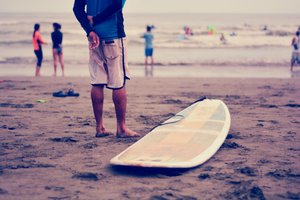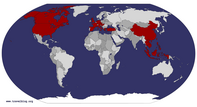Advertisement
Published: December 31st 2013

 In-Between Lessons
In-Between Lessons
A surfing instructor watches while taking a break with his surfboard at Sabang Beach“If you’re feeling the board’s nose rising, just slide forward,” Miguel yells at me, his voice drowned by the strong winds and large waves. “Think of it as riding a bike – the more you think about what you’re doing, the more likely you’ll fall.” I’m perched atop a faded blue surfboard, trying to maintain balance while a succession of swells tries to knock me over. I try to erase all worries – not actually fear, since I love water (maybe because I’m an Aquarian) – and not care about all that’s around me.
Ah, the things around me. I’m surrounded by other surfing neophytes unmindful of the chilly December winds, as we learn how to conquer the waves. I’m in Baler, the capital town of Aurora province in northeastern Philippines, popularized by two films – first, as the location of that surfing scene in the Francis Ford Coppola-directed
Apocalypse Now, and second, as the setting of a Filipino war romance film.
Sandwiched by the Pacific Ocean to the east and the impenetrable Sierra Madre Mountains to the west, the province of Aurora is cut off from the rest of Central Luzon, an administrative region to which it belongs.

 Ditumabo Falls
Ditumabo Falls
A beautiful 100-foot waterfalls concluding a rocky drive and a 20-minute trekIt’s defined by huge swathes of strikingly raw beauty that’s increasingly becoming hard to find in region, which is why the local government is drumming up adventure tourism in the province. But for all practical purposes, Aurora's tourism industry still hinges on Baler, which remains a surfer town with a matching chilled vibe to boot. And I’m trying (miserably) to be a part of it.
Miguel is one of the numerous surfing instructors in Sabang Beach, a place that has increasingly become popular in recent years as the surfing culture continues to catch on among Filipinos. “You must learn to be patient,” he tells me as I get knocked out of my surfboard. “Through patience, you learn to be calm.” And there is that word again,
calm.
I get back on the board as a large wave comes right at us, gaining size and momentum. I paddle eagerly towards it. I can feel it rumbling as it picks up speed. I stand up.
I’m calm, I’m calm, I’m calm. I’m hoping that if I tell myself that enough times I’ll eventually believe it.
“This is the big one,” Miguel yells again. “Get ready for it!”

 Monkey Game
Monkey Game
Climbing a century-old balete treeThere is no sound but the gentle, cold breeze and the waves crashing to the sea. “This is why I fell in love with Baler,” my guide and tricycle driver Mang Dong tells me, his tone as relaxed as the crisp, sunny weather. We’re on Ermita Hill, a viewpoint created in the Spanish period to serve not only as the recreation site of the friars, but also as a lookout point for pirate attacks and possible invasions. Today, it has mainly become one of the town’s tourist attractions, providing a picturesque view of Sabang Beach and the nearby Cemento Beach. At the hill’s foot, there are sculptures depicting the four families who survived a tidal wave that wiped out the entire town in the 17
th century. I shudder. The huge storm that hit the central part of the Philippines last month brought me a deeper respect for the increasingly unstable meteorological and geological patterns.
Mang Dong, 51, is one of the numerous tricycle drivers permitted by the local government to tour visitors around town. A former soldier from Davao City, he returned to the civilian world in 1986, disillusioned with military life. “I can take fighting

 View From The Top
View From The Top
The view of Baler Bay from the historical Ermita Hillwith Muslim rebels during the Marcos era,” he says as we make our way down the hill. “But then the conflict was resolved and we were being reassigned to Samar to fight communist rebels. I decided I had enough.” So he packed his bags to live with his brother here. He met his wife, settled down, worked as a tricycle driver, and bore three kids.
Today,
Mang Dong, whose tricycle was the first to pass by as I got out of the hotel this morning, is giving me a tour of his adopted homeland. Our first stops were the sights around the town center – the town museum, the ancestral house of Aurora Quezon (President Manuel Quezon’s wife and after whom the province was named), and the church where a group of Spanish soldiers holed up trying to make a last stand against Filipino soldiers. After Ermita Hill,
Mang Dong drives me to the Cemento Wharf and the largest
balete tree in the province.
We have lunch at the amusingly named Foods Pa! (which roughly translates as “More Foods!”), a cheap roadside eatery where customers choose among several
ulam (viand) displayed by pointing at them. A
turo-turo, in

 Museo de Baler
Museo de Baler
Artworks inside the town museumother words.
Over my
tapsilog and his
ginataang langka, I ask
Mang Dong more about the province – its cuisine, in particular. “Aurora doesn’t really have a specialty,” he shrugs. “The cuisine here has been largely adapted from neighboring provinces so we don’t have a cuisine to speak of.”
As we finish our meal, my companion dishes more stories of his past, when concrete structures were all but a novelty in the province.
……….
Leaving Baler proper, we drive in the afternoon to the Ditumabo Falls in the nearby village of San Luis. The journey by tricycle to the site is a challenge, to say the least, with large rocks sending our overmatched vehicle jumping like it’s going to topple over. The trek to the falls is neither a walk in the park, so to speak. En route, we cross rickety bridges, raging waters, and slippery boulders. But
Mang Dong, the ex-soldier that he is, gallops across the rocks with the worry of a six-year old child playing hopscotch.
Making our way to the falls, more visitors appear heading to the opposite direction, trudging down in staggered lines. A large family with a grandmother and

 Doña Aurora's House
Doña Aurora's House
Interiors of the home of Aurora Quezon, whose name the province borrowedtoddler in tow gingerly make their way across the river. As each step brings us closer to our destination, the hard slog is slowly transforming to amazement. At the end of the trail, the arduous paths give way to a hundred-foot falls where a just-finished hydroelectric dam and magnificent wide, green basin are flanked by towering cliffs. A handful of people are bathing in the cold – really cold – waters.
I’m wading in the knee-deep parts when a woman with her guide swims past. The guide takes a few pictures of the woman, who swims for a short while before climbing out of the water. The woman and I really don’t talk to each other, but we nonetheless start to walk back with our respective guides to the parking area together.
After a few minutes, the woman and her guide have overtaken us while I carefully negotiate each rock and
Mang Dong is deliberately slowing down to wait for me. A few minutes more, the woman and her guide are gone.
“Are you scared of the water?”
Mang Dong asks.
“Actually, I like water,” I reply. “It’s the moss on the rocks I’m worried about.”

 Church of San Luis Obispo de Tolosa
Church of San Luis Obispo de Tolosa
The church where the Siege of Baler (July 1, 1898 - June 2, 1899) took place……….
I spend the evening in the hotel dining area, talking with a woman who offers me a local wine. I pour some on a glass and play a couple rounds of Candy Crush on my tablet. At another table, I spot the woman I met at the falls earlier. She sees me as well.
Our conversation begins with the following exchange:
“Hey!” she exclaims.
“Hey!” “Aren’t you the guy at the falls?”
“
I am!” “Small world.”
“It is.” And so it turns out that we share more things in common than just bumping into each other twice in the same day. We both work in the same building in Makati, and we ended up in the same hotel through Agoda, because all other hotels are full. I learn her name, which is unusual (“I know, they say it sounds like a name of an antagonist in a
telenovela”), starts with G and is the first two syllables of an MRT station. She’s a mountaineer, which explains why she took that trek earlier so effortlessly and she offers to let me join her outdoor group for some of its

 Diguisit Beach
Diguisit Beach
Waves crash into the rocks at one of the beaches near Baler.future mountain assaults.
The woman who offered me wine smiles and butts in. “Isn’t that amazing? Two solo travelers finding each other and sharing a connection.”
The next morning is G’s last in Baler. After a night of intermittent sleep, thanks to my messed up body clock due to my work, we ride a tricycle to the bus terminal. There we bid each other goodbye as she rides the bus, then I, after taking care of my reservation for the evening trip back to Manila, return to the beach to have my first surfing lessons with Miguel.
After the session, I eat my lunch at the nearby
sari-sari store. Instead of sleeping to ease the nagging lightheadedness, I turn my attention to the sea, and join the people riding the waves. All I care about again at this moment is all that’s in front of me. I grab a board and run to the water to meet another giant wave coming right at me.
Advertisement
Tot: 0.111s; Tpl: 0.014s; cc: 15; qc: 29; dbt: 0.047s; 1; m:domysql w:travelblog (10.17.0.13); sld: 1;
; mem: 1.1mb



























taracloud
Tara Cloud
Paradise!
A little town sandwiched between ocean and mountains and with nearby waterfalls and museums sounds like paradise to me! Don't know if you ever caught a wave (not so easy), so it sounds as if you may need to return to paradise to practice some more! Great video--felt as if I were there.